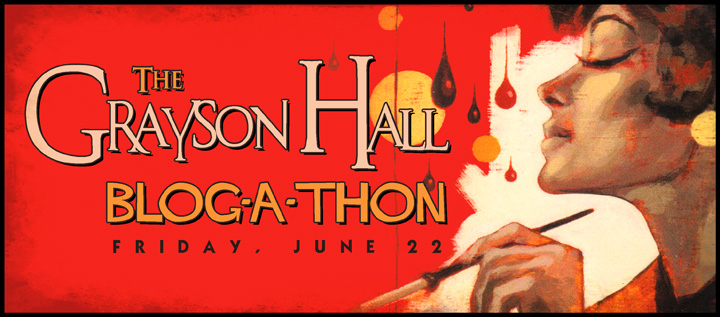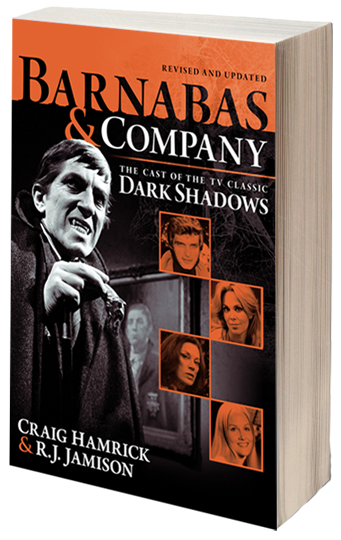 BCO is participating in the Collinsport Historical Society’s Grayson Hall Blog-a-Thon.
BCO is participating in the Collinsport Historical Society’s Grayson Hall Blog-a-Thon.
Other participating sites blog entries hyperlinks are below.
Our first Blog Entry today is by S. R. Shutt.
Noble accents, inescapable rhythms: thirteen ways of looking at Grayson Hall
By S. R. Shutt
In honor of a day of writers sharing their thoughts about the artistry of Grayson Hall, I present these reflections, playfully inspired by Wallace Stevens’ short verse cycle, Thirteen ways of looking at a blackbird. Curiously, when the thought came to whisk up such a confection, the association with the Stevens verses seemed completely random. But I have the poem before me now and I see many phrases that evoke the lingering theatrical beauty of Grayson Hall:
I do not know which to prefer,
The beauty of inflections
Or the beauty of innuendoes, …
I know noble accents
And lucid, inescapable rhythms…
The blackbird in Stevens’ cycle could be compared to a sense I often find in Grayson’s work of something unseen, indelible, poignant, and implicit yet very much present; an emotion, a sense of intellect, a sense of passion, often a sense of slashing wit barely muted in the service of her art. I often feel that a caustic humor is never very far away from the moments of seriousness in her work. In conversation, a clever trick she had of damning a film or novel with faint praise was to declare it “earnest.”
I.
In her numerous late Sixties and early Seventies press interviews, Grayson always described Night of the Iguana as her first film. In fact, it was her third (or fourth, if you count 1963’s The Parisienne and the Prudes, in which she was onscreen for all of about two minutes). Her first film was something called Run Across the River, which appears to be lost. It was filmed in about three weeks during the summer of 1957. Fellow players included Jerry Stiller (apparently also his first feature film) and Robert Carricart (a co-star of the 1966 cult series T.H.E. Cat). Grayson’s character was described by her in a 1960 interview as a “beatnik poetess,” and on a lobby card there’s a shot of what appears to be her character performing a weird dance. In my mind I imagine how she must have moved in this unseen world, a sly sylph in black with enormous eyes conveying her razor-sharp read on the world of the Village at the height of the Beat movement. I wonder what lines, what exotic and non sequitur phrases she may have declaimed in character as this wayward, amorous poet caught up in a violent scheme. I wonder about the image of Grayson, in that summer of 1957, trying out the world of film after a string of off-Broadway roles. Does my sense of wonder at it all match her own emotion as she turned towards the camera and began to recite? Or was her inward thought simply an impatient urge to get on with the latest job and move on to the next thing?
II.
Scene from Satan in High Heels: Grayson as the uber-sophisticated Pepe, attired in black bolero elegance with cigarette holder perched at an acute angle between long psychic fingers, tells a surprised cabana girl: “This is my last season. I’m buying a rocking chair and keeping a cat.” Sabrina (Norma Sykes) sails past, chirping “Bon soir!” and without missing a beat, Pepe raises an eyebrow and states: “I’ve changed my mind. Who wants a cat?”
III.
Grayson onstage in the Summer of 1961, at the Hedgerow theatre, not far from where she was born in Philadelphia, performing alone in Cocteau’s tour-de-force one-act play, The Human Voice. Described in Cocteau’s Wikipedia entry as presenting “a woman alone on stage for almost one hour of non-stop theatre speaking on the telephone with her departing lover … [a work] full of theatrical codes harking back to the Dadaists’ Vox Humana experiments…” Critical jaws dropped at the sight of Grayson’s sheer emotional ferocity in this incredible role, and even her twenty-first century fans might have been startled by how thoroughly she gave herself over to the demands of this work, raging, cooing, barking, haranguing, building an emotional storm that found eventual climax in the work’s grimly nihilistic conclusion.
IV.
Grayson on radio. “A weekend at Gleebes” appears to have been one of the final scripts produced, in July 1962, for the long-running series Suspense. The play was the work of actress-playwright Elspeth Erica and Grayson portrayed a woman caught between the demands of motherhood and the hope for a new love. One of the very few times she was cast in the role of a troubled romantic heroine. She infused the role with a plausibility and quiet pathos that made the work memorable and worth revisiting.
V.
Grayson as Miss Fellowes, running in headlong hysteria on a beach on Puerto Vallarta, sobbing and screaming at Richard Burton: “You beast… you BEAST!” Critics around the world sat up and took notice. At least one wrote that this moment was the one point at which Huston’s sometimes static drama really came to full kinetic life. Richard Burton told her in a bar: “When you’re on camera, love, none of the rest of us exist.”
VI.
Backstage in New York a few months later, Grayson and Elizabeth Taylor have lifted skirts to compare suspicious spots they both came home with from their sojourn in Mexico, and a waggish photographer has snapped pictures. Taylor marches up to the man, grabs his camera and relieves it of the film. No photos survive of this event, but the occasional shot of Grayson (who had freckles and wore leg makeup) in a short skirt show that her shapely legs would have had nothing to be ashamed of side-by-side with those of la Liz.
VII.
Grayson on Man from U.N.C.L.E. as a lethally glam New York literary critic (from the pen of Harlan Ellison, based on his dear friend Judith Merrill), lolling against an elaborate headboard with typewriter on her bed, quizzed by Theo Marcuse as THRUSH supremo Ellipsis Zark: “Do you do all your work in bed?” “Only… during the day!” she croons, followed by a long smokily liquid laugh.
VIII.
Grayson, placing a bowl of white flowers against the Pompeiian red backdrop of a wall in her seven-room New York apartment, moves to infuse with perfume a pewter flower created for the Queen of France in the 18th century. Thing, her ankle-biting pug, looks up, disconcerted, as the sharp fragrance of the perfume drifts across a careworn woman’s flickering profile. Her face is a poem of light and shadow as she turns into the afternoon sun and contemplates life as an unemployed actress in the 1960s.
IX.
Grayson, struggling to break out of insidious Hollywood typecasting, plays a sex scene opposite Stacey Keach in the film adaptation of the John Barth novel, End of the Road: “two teachers of English… veddy Noel Coward.” In fact, Grayson had met Coward in Connecticut at the beginning of the 1950s while working in the unsuccessful William Marchand play, Under a Glass Jar. Grayson’s unfettered eroticism in this scene still to this day shocks fans who associate her with “that tightass doctor” (as Grayson herself described her character) on Dark Shadows. By the time End of the Road was released in 1970, it was rated X, received extremely limited distribution, and hence was never seen by most of her fannish “Legion” of the day.
X.
I show Sam Hall a publicity shot of Grayson striking a flamboyant pose in her batwing gown from Night of Dark Shadows, found by cinema history authority Darren Gross (who has been working on the NoDS restoration project for over a decade) and printed on the back of an issue of Video watchdog magazine. “I wonder what she was thinking when this was taken,” I mused, studying Grayon’s hollow-eyed, hollow-cheeked, haunted expression. Sam looks at the photo a moment, gives a wry scowl, and says: “Probably something like—‘this dress is too goddamn tight!’”
XI.
Grayson remembering her work as Warda, Queen of the Whores (who spends the latter part of the play appearing as a ghost) in Genet’s play The Screens in December of 1971:
“It was an ENDLESS play. I had two hours between scenes. And I couldn’t go out because I had this incredible make-up on, which was clown-white with purple lips and … oh God, it was all bizarre…There is a photograph of me which is really quite fascinating with this WILD make-up on and–I had styrofoam breasts, and HAT-PINS stuck in them–and I remember Willa Kim did the costumes, and she put me in these things and there were these styrofoam breasts–and then she came AT me and started putting these hat-pins in and I said, “God! Nobody’s gonna look at me! It doesn’t matter WHAT I say, they’ll be STARING at these HAT-PINS sticking in my styrofoam BREASTS.” And then they said they couldn’t use any photographs of me because it would be–you know, it would look LEWD in the newspapers. And then [laughs infectiously] of course it was the photograph they chose for the Theatre World. Who can figure ANYTHING?”
XII.
Grayson, in a dignified pantsuit, plays the Producer in the mid 1970s play-within-a-play presented off-off-Broadway, Jack Gelber’s New Play: Rehearsal, at the American Place theater. Gelber was one of a number of avant-garde playwrights whose work Grayson supported and performed during the 1970s. In a still, the Producer is seen considering whether a male-on-male prison inmate rape scene should be performed onstage or suggested by shadows from the wings. Grayson’s look in the role is one of gritty determination. It is a moment of offbeat Seventies zeitgeist.
XIII.
Grayson, informing a fan how to handle frustration: “What you must do, darling, is to get in the car, roll up the windows, and SCREAM. You’ll feel so much better afterwards.”
Blog-a-thon Grayson links:
Collinsport Historical Society Jonathan Frid was the face of Dark Shadows, but Grayson Hall was it’s soul. Even though nobody ever made action figures or board games baed on her characters, Dark Shadows wouldn’t have been the same without her. Plus fan art, vintage newspaper clippings about Hall’s stage career and more throughout the day!
The Performance Art of Grayson Hall: Life On Two Levels Using lines from her Oscar-nominated film Night of the Iguana as thematic bookends, Frank Jay Gruber discusses the differences between Grayson Hall’s film and television performance styles, and why each is distinct and memorable.
The Collins Foundation “If you have to choose between real and interesting, choose interesting.” According to Patrick McCray, Grayson Hall gives us both in Dark Shadows.
General Grayson links:
Matt Hall (son of Grayson and Sam Hall) blog
Grayson Hall Official biography website
Dark Shadows Blog-Finding Grayson
Chronicling the Life of Grayson


